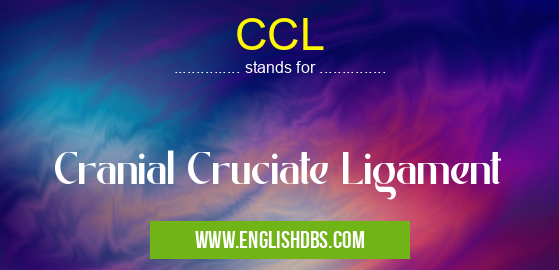What does CCL mean in PHYSIOLOGY
The cranial cruciate ligament (CCL) is a ligament that stabilizes the knee joint. It prevents the tibia from sliding too far forward in relation to the femur. Damage to this ligament can cause a condition known as cranial cruciate ligament rupture, or CCLR. This can cause pain, instability and lameness in dogs.

CCL meaning in Physiology in Medical
CCL mostly used in an acronym Physiology in Category Medical that means Cranial Cruciate Ligament
Shorthand: CCL,
Full Form: Cranial Cruciate Ligament
For more information of "Cranial Cruciate Ligament", see the section below.
» Medical » Physiology
Essential Questions and Answers on Cranial Cruciate Ligament in "MEDICAL»PHYSIOLOGY"
What is Cranial Cruciate Ligament?
The cranial cruciate ligament (CCL) is a ligament that stabilizes the knee joint. It prevents the tibia from sliding too far forward in relation to the femur.
What happens when Cranial Cruciate Ligament is damaged?
When damaged, it can cause a condition known as cranial cruciate ligament rupture, or CCLR. This can cause pain, instability and lameness in dogs.
How do you diagnose Cranial Cruciate Ligament damage?
Diagnosis of CCL damage typically involves physical examination, radiographs and arthroscopy. X-rays are used to evaluate for arthritis. Arthroscopy allows for visualization of both the menisci and the articular surfaces of the bones along with evaluation of all ligaments including the CCL itself.
How do you treat Cranial Cruciate Ligament damage?
Treatment options depend on how severe the damage is and whether any other structures were damaged along with it. Conservative treatment may include strict rest, special diets, anti-inflammatory medications and physical therapy; surgical repair may be needed if conservative measures don't resolve the issue.
Can Cranial Cruciate Ligament damage be prevented?
To prevent CCL injuries, owners should provide appropriate exercise for their pet's age and activity level to maintain muscle strength as well as flexibility of joints including crossing motions like running up or down hills/stairs or jumping over objects on walks/runs/ hikes that can cause sudden torque leading to tears of particular tendons/ligaments like CCL's.
Final Words:
The cranial cruciate ligament is an important structure that helps keep your dog's knee stable so they can move without pain or limitation. If an injury does occur there are treatments available to help stabilize your pet's knee joint again so they can get back on their feet!
CCL also stands for: |
|
| All stands for CCL |
